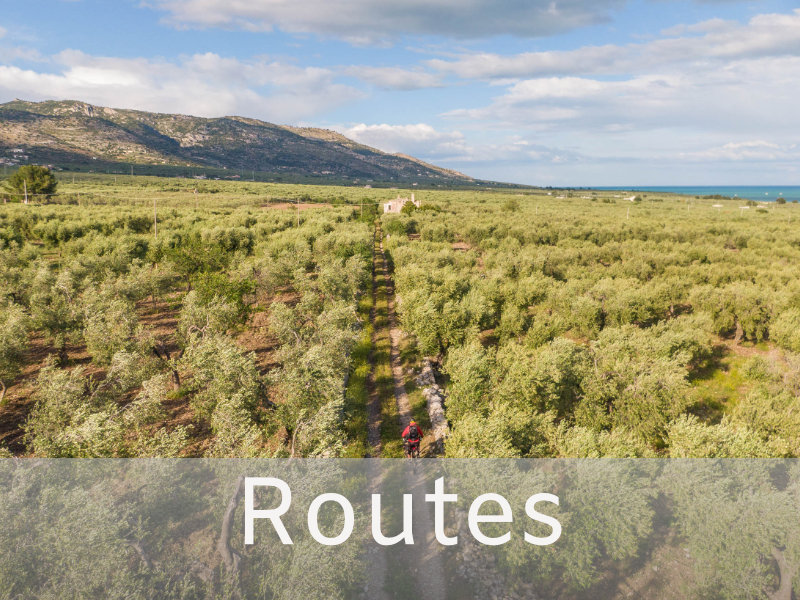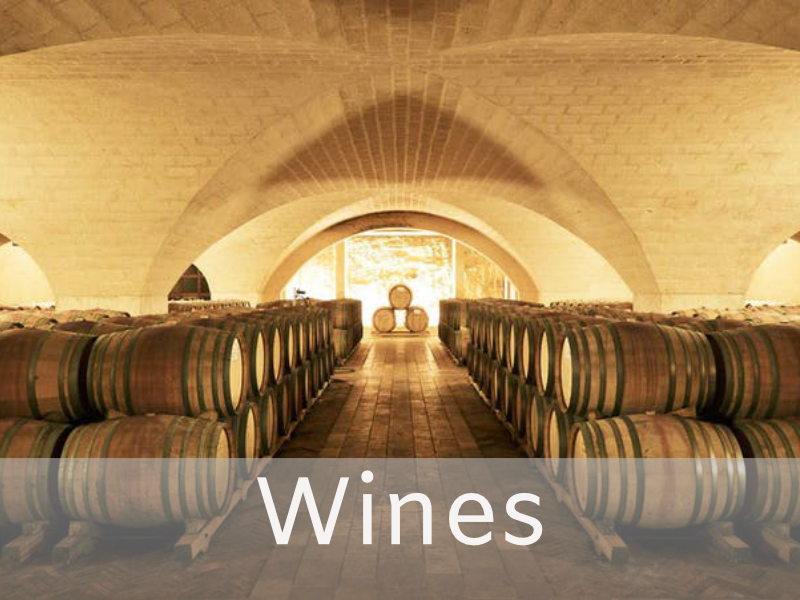Puglia Food
We are in Puglia the gastronomic center of the Mediterranean Diet, one of the most varied food and healthy diets of our time.
Here is where some of the best raw materials in Italy are produced, bred, and cultivated, raw materials that are enhanced by traditional cuisine with few interventions that preserve the primary flavors of food.
Let us try to describe the many cornerstones of this regional cuisine:
• On the Adriatic coast, cloaked in beautiful olive groves, extra virgin olive oil is obtained which strongly characterizes the flavors of each dish.
• Very popular and of high quality are the fruit and vegetable productions, turnip tops, green cabbage, thistle, peppers, eggplant, artichokes, beans, lentils, grass peas, broad beans, are the best crops in Italy. A curiosity, the Apulian families have the habit of closing the lunch with raw vegetables such as fennel, radishes, or celery.
- In the Tavoliere plain, durum wheat is grown. This the origin of countless types of pasta and the famous Apulian bread, dark and tasty. The handmade pastas are seasoned mainly with vegetables: pasta and tops of broccoli, pasta and cabbage, macaroni and eggplant, pasta and mashed beans («Macco»), spaghetti, and chicory.
- Meat sees the wide use of game, birds, pig, wild rabbit, and especially sheep meat (the region ranks third in national production). Very popular are the dishes cooked with the less valuable parts of the animals, “Gummareddi”, “Bombette”, “Turcinieddi” below we describe these local specialties.
- The fish, very abundant and of high quality on the entire Ionian and Adriatic coast 550 miles long, countless preparations of fish cooked with vegetables and / or pasta.
- Do not forget the numerous dairy specialties based on the “pasta filata” technique such as stracciatella, burrata, scamorza, and caciocavallo.
- Almonds and figs are cultivations of high quality here, they characterize the confectionery preparations that traditionally cannot be missing on the Sunday lunch table of the Apulian families.
Here too, as in all of Italy, each village has its own recipe / tradition for cooking regional dishes, resulting in an infinite series of variations on the same dish, below we describe some dish of the Apulian regional cuisine differentiated by mountain cuisine and seafood cuisine.
APULIAN MOUNTAIN COUSINE:
Three of the many appetizers offered by the Apulian mountain cuisine, the first light, aromatic, crispy, the second fat with the salty salami balanced by the sweet of the fruit, the third with a bitter aromatic component of the vegetable balanced by the sweetness of the egg fat.
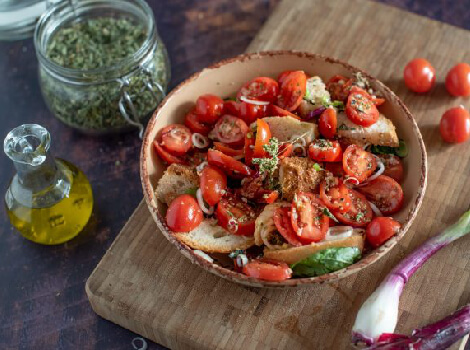
APPETIZER – Acquasala
It is a summer Mediterranean appetizer, but it was once the lunch of the farmers who went to work in the countryside away from home for the whole day. A very simple dish prepared with stale rustic Apulian bread, onion, salt, ripe tomatoes, oregano and extra virgin olive oil, for the Apulians it is the dish of childhood memories .

APPETIZER – Figs and Capocollo
Capocollo is a traditional pork sausage obtained from the seasoned muscle that comes out from the neck to the fourth or fifth rib of the shoulder or pork neck. It is a whole muscle salami, dry dried and generally very thinly sliced.
Figs are a widespread fruit in Apulia, many varieties are grown whose ripening covers a long period of the year, some varieties are suitable for drying, others are suitable for fresh consumption.
Figs and Capocollo is a classic Apulian combination, a bit like ham and melon in other parts of Italy, fresh figs with a delicate sweet non-honey flavor are used that go well with the salty salami.
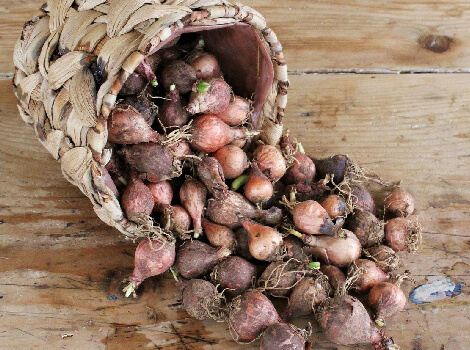
APPETIZER – Lampascioni Omelet
Lampascioni are herbaceous plants belonging to the same asparagus family, the edible part is the one at the top, which looks like an onion. They have very rustic plant with a particular taste: strong initial bitter note and round and delicate aftertaste on the finish, the smell is sweet and aromatic. They have an important aromatic profile, which is why they are used in simple preparations, they are usually sautéed whole, put in oil or under ash. The only other ingredient with which they go well are eggs: here is the Lampascioni Omelet.
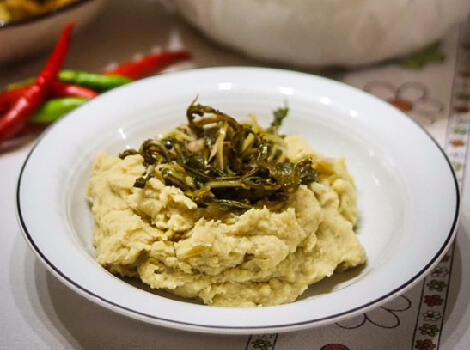
FIRST COURSE/SOUP – Fava Bean Puree (Macco)
Poor dish par excellence, in the past beans and legumes represented one of the bases of the farmers’ diet, now with the revaluation of the Mediterranean Diet, Macco is a gourmet dish. It is a very simple preparation that combines the following flavors: The sweet of the fava bean puree, the bitterness of the stewed vegetables (turnip greens, Catalan chicory and wild herbs) and the aromatic of the Apulian extra virgin olive oil, the spicy note some chili peppers.

FIRST COURSE/PASTA – Orecchiette alle cime di rapa
Dish emblem of Apulian cuisine, it contains the typical ingredients of this region: durum wheat pasta (Orecchiette), typical vegetables (Cima di Rapa) and extra virgin olive oil.
Le Orecchiette is an handmade dry pasta from Puglia, with a circular shape, rough with a central hollow given by the pressure of the thumb. It is dried so that it can also be kept for long periods.
Cima di Rapa (Brassica rapa sylvestris) is a typical vegetable that is consumed in the autumn / winter period, it is a vegetable with a strong flavor very appreciated for its tastiness. The extra virgin olive oil characterizes the dish with its strong structure and aromaticity.
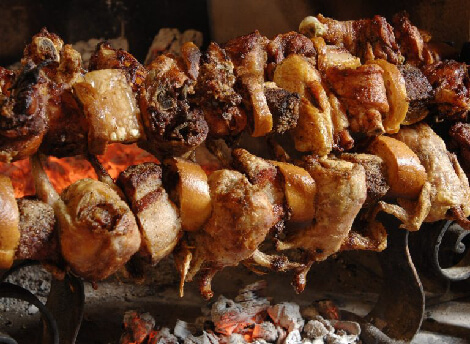
MAIN COURSE – Fornello Pronto
It is difficult to explain what the “Fornello Pronto” is, we try:
- Are widespread only in Apulia in the internal areas of the region.
- Is an ancient artisan tradition that is very current, the presence of the butcher is a guarantee of the freshness and goodness of the meat and the competence in preparation and cooking.
- They are the traditional specialties, the lesser-known cuts that are difficult to prepare are used: the Diaframma, the Gnummarieddi / Turcinieddi / Bombette (preparations based on lamb and kid entrails), Marro (meat offal wrapped in sheep guts), Zampina (mixed pork and veal sausage) and many many many many more.
- Each village has its own specialty, preparations are eaten convivially in the butcher shop.
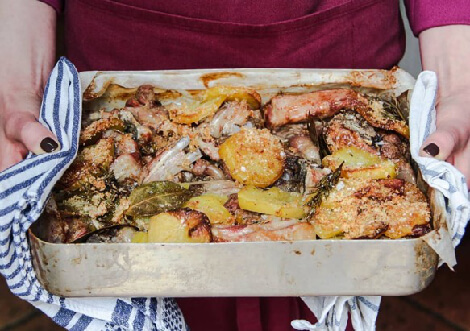
MAIN COURSE – Agnello Mollicato alla Lucana
The farmers ‘/ shepherds’ diet was low in meat, the meat, usually sheep or lamb, was eaten only on Sundays or on important occasions.
This lamb preparation is a traditional dish cooked in a crock pot, in a wood oven, which combines the intense characteristic flavor of lamb with that of Pecorino Lucano cheese, accompanied by potatoes, vegetables and wild mountain onions, aromas and finished with extra virgin olive oil. Tradition has it that the lamb of the Lucanian Dolomites is used, bred purely in a semi-wild state.
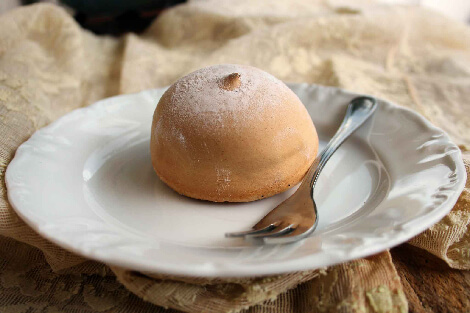
DESSERT – Tette di Monaca (Nuns’ boobs)
There is a legend that tells that this dessert is a tribute to Sant’Agata, co-patroness of Gallipoli and patroness of Catania, whose breast was torn as punishment for not giving in to the sexual demands of Quinziano, a Roman proconsul.
They are part of the Altamura pastry tradition, it is a difficult preparation, the processing is strictly handmade, they are domes of soft sponge cake stuffed with custard or Chantilly cream,
The nuns of the Monastery of Santa Chiara di Altamura prepare them and sell them in their pastry shop.
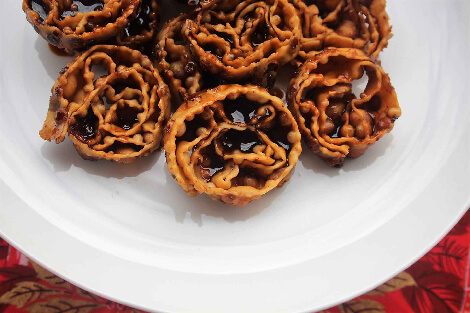
DESSERT – Cartellate al Vin Cotto di Fichi
It is the traditional Christmas dessert, the tradition dates back to the ancient Greeks, it is a poor dessert made with different rustic flours with which you make strips of pasta which are then fried.
To complete they are sprinkled with the syrup “Vin Cotto of Figs” made by boiling, red wine, figs, carobs, quinces.

EXTRA – Altamura Bread DOP
It is the most famous artisanal bread in Italy, it is a protected designation of origin (DOP) product produced by the bakers of the city of Altamura, only 20 bakers are licensed to do so. It is obtained from a mixture of durum wheat semolina, grown in the villages of the Murgia, very rich in gluten (up to 14%), naturally leavened, without preservatives and cooked in a wood oven.
The main characteristics are the crunchiness of the typical brown crust, the softness of the yellow crumb, the high digestibility and the excellent preservability.
The large formats are kept for up to a month, when it is stale it is used in the kitchen in the preparation of typical dishes
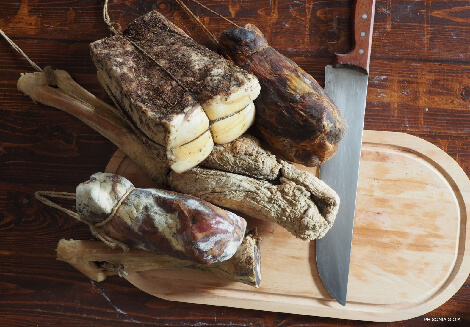
EXTRA – Salumi Pugliesi (Apulian cold cuts)
The pork butchery and the preparation of cured meats is a very developed art in Puglia, in the region there are productions of excellence possible thanks to the breeding of pigs and wild boars in the wild. They are usually eaten as an appetizer accompanied by fruit (figs or melons) or mixed pickled vegetables.
The best known cold cuts are:
- “Capocollo“, produced using the cervical part of the whole pig, is smoked with oak bark
- “Sausage with a knife tip“, is a coarse-grained sausage obtained by dicing shoulder, bacon, thigh and lard into cubes. It is eaten seasoned raw, or cooked on the grill.
- ”Sweet Sopressata“, is a sausage produced with wild animals, the meat is cut with a knife, salted, flavored and mixed with ”Vin Cotto” sauce, then slightly smoked with beech bark and finally pressed between marble slabs to 60 days.
APULIAN SEA COUSINE:
Three fish appetizers of the Salento tradition, the iodized freshness of fresh fish, the sweetness of the mussels and the acidity of the vinegar accompanied by the bread in the Scapece fish.
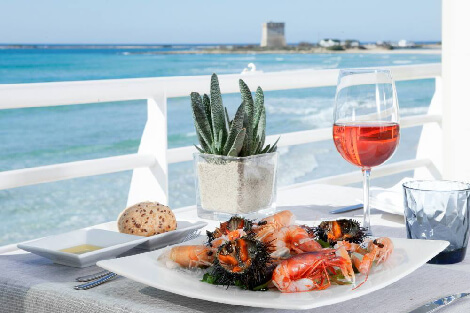
APPETIZER – Raw Fish
Bari is a city overlooking the sea and fishing has always been one of its main activities. In the past, fishermen, after selling fish caught overnight, brought home the unsold small fish that ate raw. Hence Bari’s love for raw fish, now splendid dishes based on mollusks, crustaceans, shells, and fish tartare of the highest quality are served.
In Puglia, it is a tradition that the wedding banquet must start with large raw fish dishes, it is a belief it brings good luck for the married life of the couple.
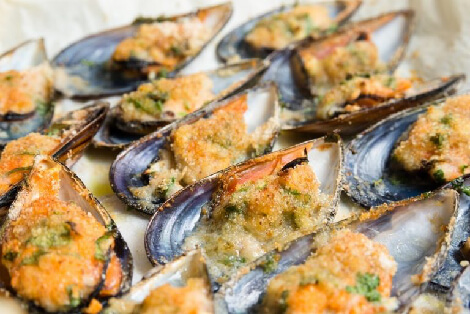
APPETIZER – Cozze Arraganate
A dish prepared with the Taranto mussels, which has been bred for centuries in the Taranto Lagoon called Mar Piccolo, an ideal cultivation area thanks to the numerous freshwater currents that mix with the salty sea. These mussels are small, fleshy and sweet, white-pink in color, prepared “arraganate”, stuffed with egg, parsley, and cheese, extra virgin olive oil, garlic, and breadcrumbs, then baked au gratin.
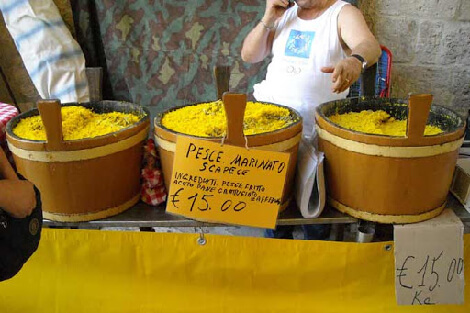
APPETIZER – Pupiddi alla Scapece
“Scapece” is the method of preparation and conservation of blue fish, this rustic dish has become an integral part of the Salento gastronomic tradition. The “Pupiddi” are the young ones of Menola or Zerro, two varieties of blue fish. They are whole fried and marinated in the scapece, breadcrumbs of grated stale bread and marinated in a preparation based on vinegar and saffron. Saffron gives the dish a golden yellow load, they are stored stacked in large wooden tubs.
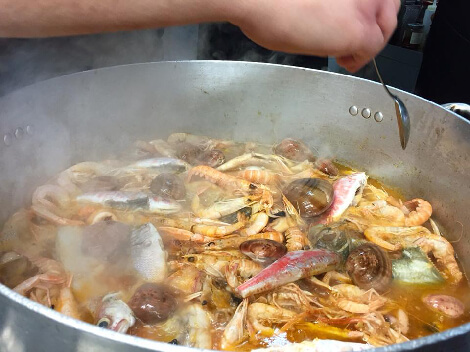
FIRST COURSE/SOUP – Brodetto o Ciambotto Pugliese
“Brodetto” or “Ciambotto” is a fish soup where different types of small-sized fish considered to be second choice, compared to more well-kept fish such as sea bass, sea bream, monkfish etc, are used. It is the fish that remains unsold at the end of the market on the fishermen’s stalls, this does not mean that the result is not tasty and good quality, on the contrary it is an excellent dish with an intense flavor of the sea with a great sea food typicality.
It is seasoned with extra virgin olive oil, white wine, cherry tomatoes, parsley, but the secret is fresh fish, freshly caught that still smells like sea iodine.
It is the Friday dish, the other days it is prepared on-demand, it is not possible to cook it in small quantities because the flavor would not be so intense.

FIRST COURSE/RIZ – Tiella Barese
In Bari it is called Tièdde, in Salento Taieddhra, in the rest of Apulia Tiella, it is always of the same dish that unites across Apulia.
It is a cake made of layers of rice, potatoes and mussels, flavored with garlic, onion, tomato, parsley, sprinkled with pecorino cheese and with extra virgin olive oil.
The type of rice used rice must be of coarse grain and with excellent absorption capacity, the potatoes must be rustic with yellow pulp and the mussels sweet ones grown in the Mar Piccolo of Taranto.
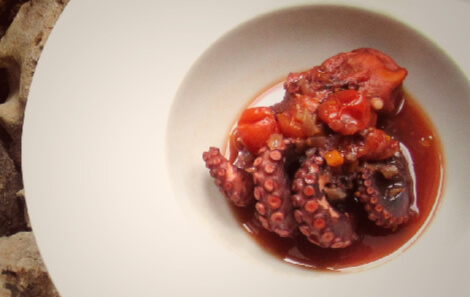
MAIN COURSE – U Purpu alla Pignata
Ancient Salento recipe whose name derives from the typical earthenware pot in which it is cooked, “pignata”. The octopus caught in Apulia is large and rich, it can be recognized by the double row of suckers on the eight tentacles and is very suitable for long cooking. Its meat is quite hard and therefore as soon as it is fished it is usually beaten several times with force on the rock to make it tender.
It is cooked for a long time with ripe tomatoes, potatoes, wild onions, garlic, bay leaf, parsley and extra virgin olive oil, no water is added, it cooks in its salt water which has filtered from the sea.
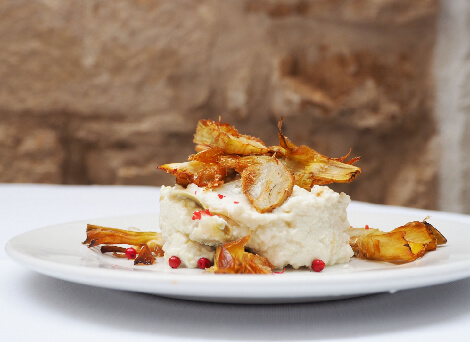
MAIN COURSE – Norvegian Cod (various recipes)
The Norwegian Cod arrived in Apulia with Federico di Svevia to feed his army, easy to preserve and then became widely used. In the Apulian regional cuisine, it is prepared in many ways, the most interesting:
- Cod flan with fried wild artichokes (in the picture),
- Savoy cabbage stuffed with cod, cherry tomatoes and capers baked in the oven,
- Murge black chickpea soup with cod,
- Bean and cicerchie beans soup, cod and Senise cruschi peppers (very rare crispy pepper specialty).
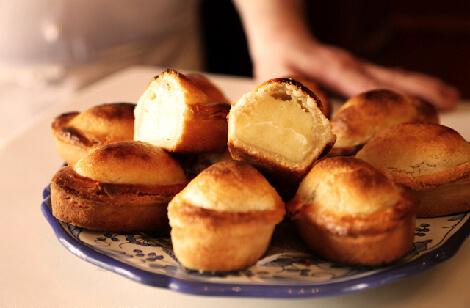
DESSERT – Pasticciotto Salentino
Rustic dessert with an intense, almost aggressive flavor, made from a pastry shell with a custard filling. The crumbly shell delegates the task of giving sweetness and creaminess to the custard.
In addition to being eaten as a dessert for breakfast, in summer accompanied by a cold coffee with almond milk, in winter with hot creamy cappuccino.

DESSERT – Cupeta Salentina
One of the classic Salento sweets, a delicious crunchy almonds Puglia IGP variety «u riviezz», vanilla sugar, flavored with lemon, of Arab origin is served at the end of the meal with coffee.
It is the sweet of the patron saint’s feasts that take place in the summer in the Salento villages, you can buy it in the stalls selling sweets, figs and dried fruit. A word about the Apulian almond variety “u riviezz”, a quality cultivation that has always been used in pastry for typical preparations: “pisquett”, “cupeta”, “real pasta”, “marinated figs”.
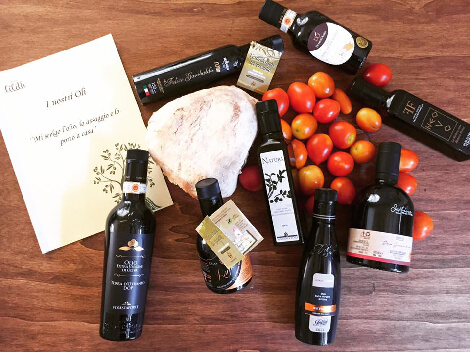
EXTRA – Apulian extra virgin olive oil
Extra virgin olive oil is the element that best defines the Apulian territory, not only from a culinary point of view, but also from a social, economic and landscape point of view.
The expanses of olive trees are part of the Apulian landscape, the perfume that these olive trees spread has become the perfume with which we identify Puglia.
Difficult to defy in few lines the production of such important quantities and qualities, the best types of olives grown are:
- Cellina: typical oil olive, used to flavor vegetable dishes (wild herbs), bread, pizza and baked focaccia.
- Coratina: used to create spicy oils, it is very valuable.
- Ogliarola: the most common in Puglia. It has a delicate flavor, between fruity and almond, excellent for cooking meats.
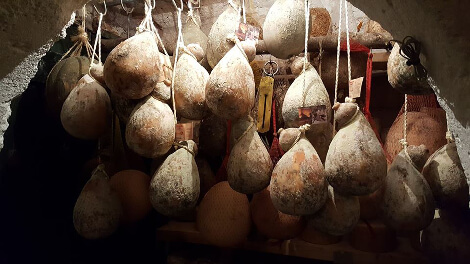
EXTRA – Burrata and Caciocavallo Cheese
Apulia is the region where the dairy processing of “pasta filata” products reaches the highest quality level in Italy. For pasta filata is meant the type of processing of milk curd with boiling water which reduces the casein into very thin and long threads, thin threads which are then used to prepare the typical cheeses of southern Italy such as mozzarella, burrata, and caciocavallo.
The two most representative cheeses of Apulia are the Burrata and the Caciocavallo Podolico two cheeses on the opposite side, to be eaten very fresh the first, to be eaten aged the second.
The best way to taste them: with rustic vegetables or tomatoes the Burrata, with chestnut honey or citrus jams the Caciocavallo Podolico.
.

